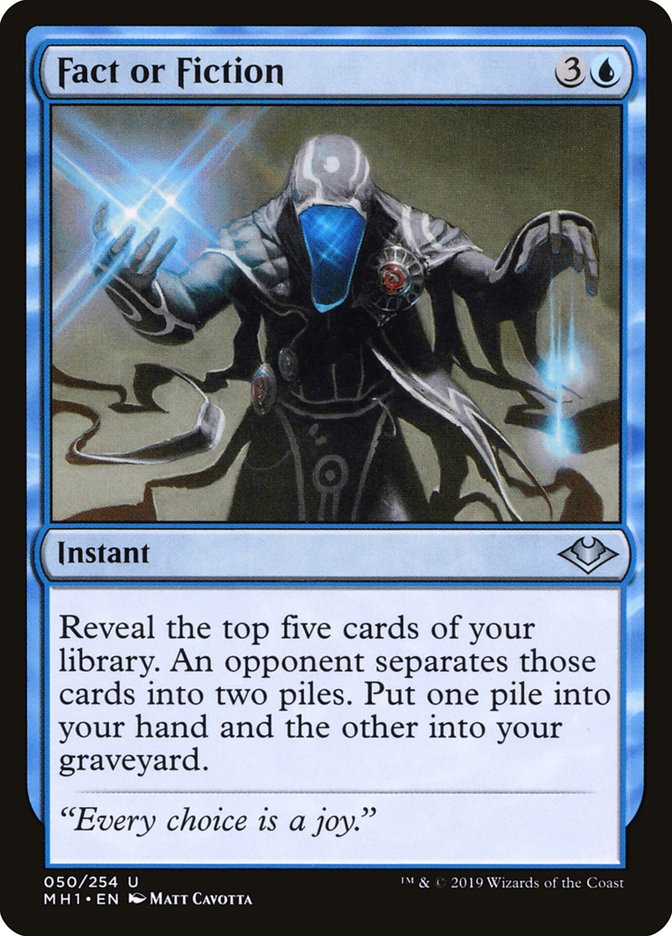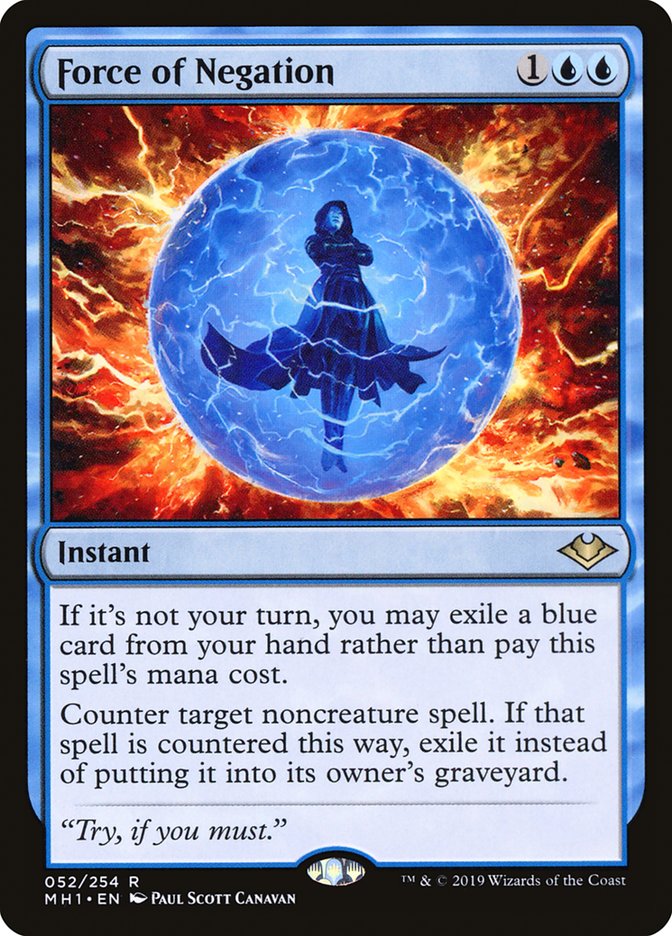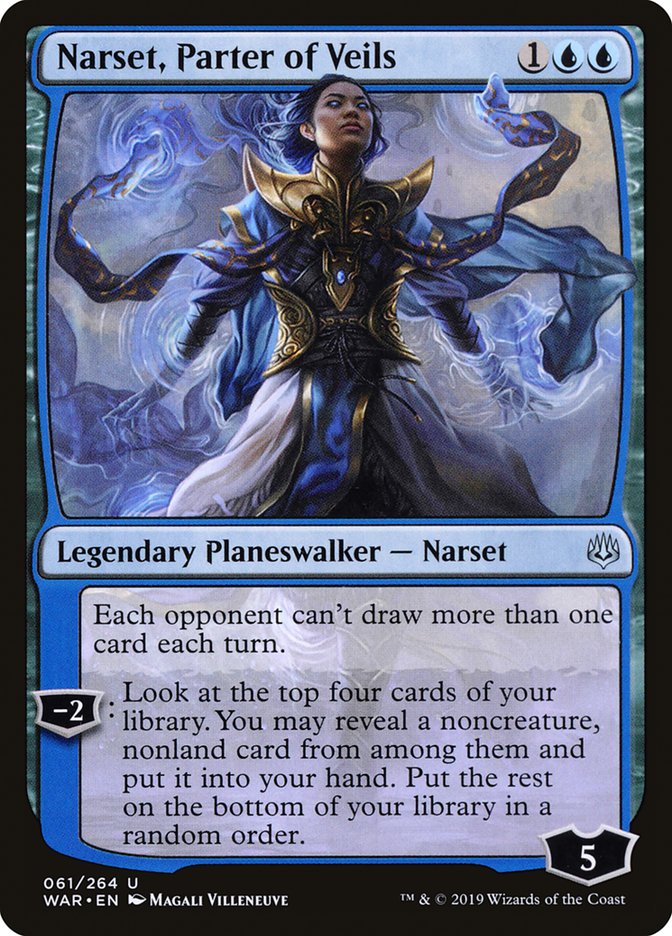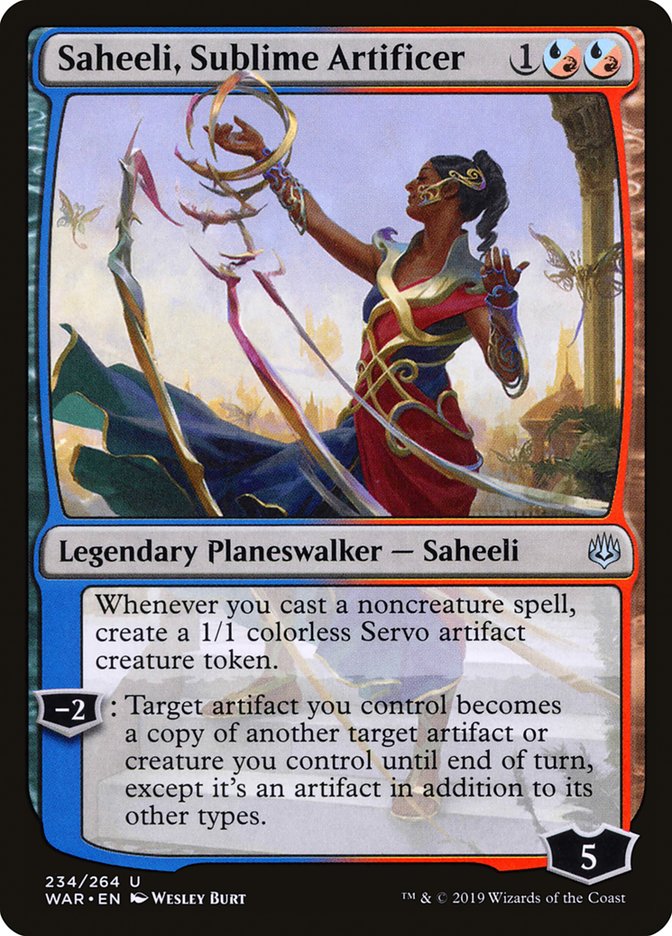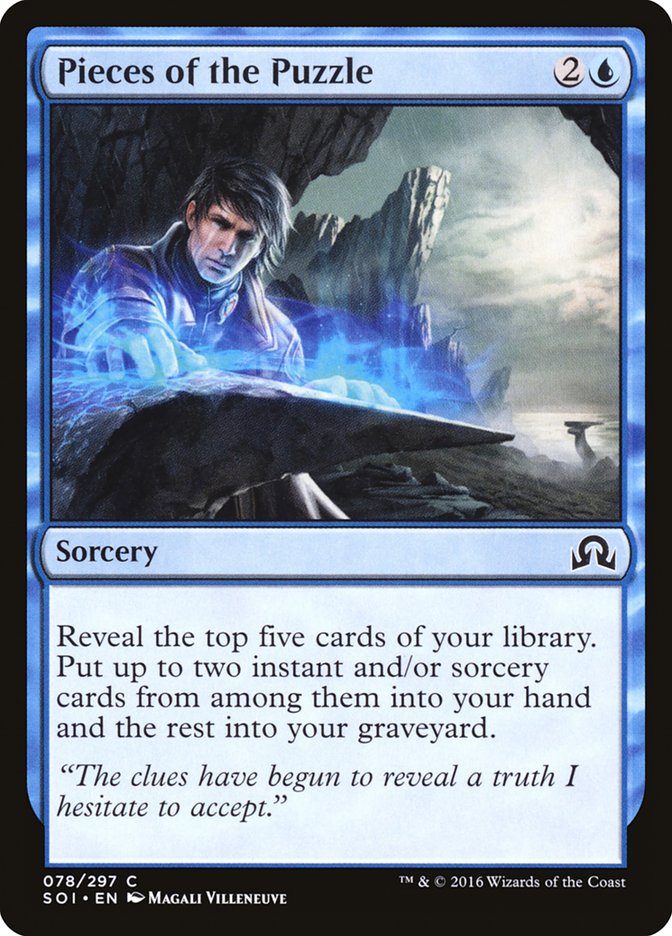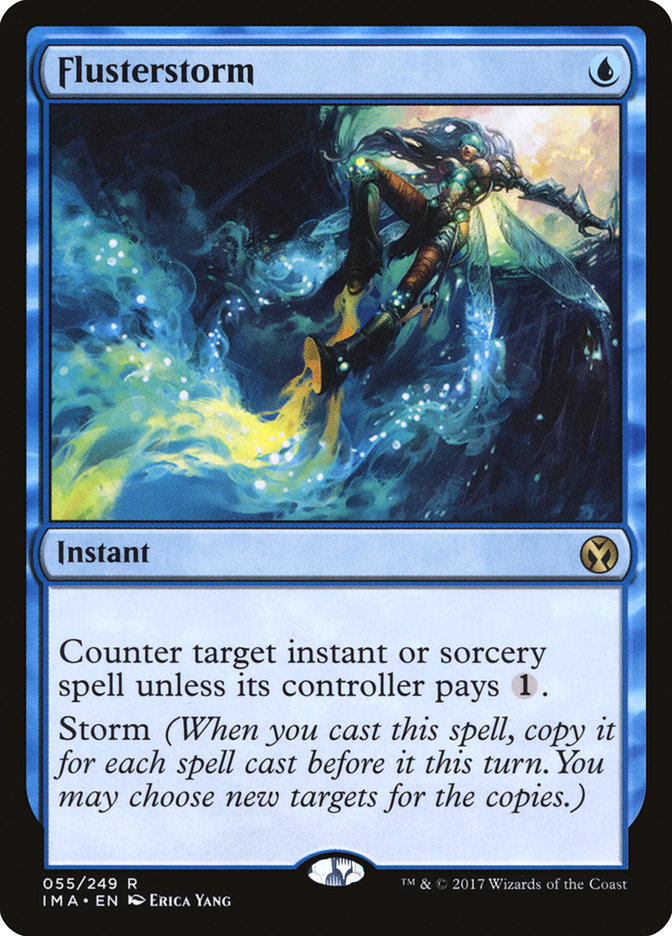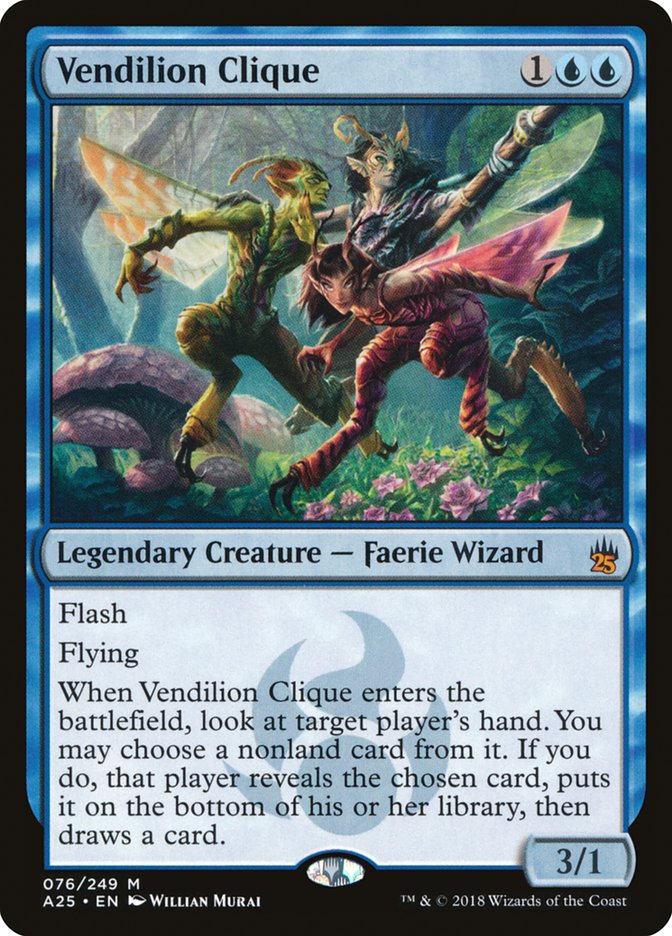EOTFOFYL.
It was one of the first bits of Magic slang I picked up, some fifteen years ago from somewhere deep in the rabbit hole of old Mike Flores articles or old tournament coverage. It was one of my first glimpses into the world of real, raw, massive card advantage (remember the days when you didn’t understand why Ancestral Recall was too powerful?). And it was one of those cards I never quite got the chance to play with, because by the time I was experienced enough to play more than my local Standard tournaments, it had rotated out of Extended. I tried to play it once or twice in Legacy, but it never quite worked out how I wanted in the format defined by Wasteland and Daze. For the entirety of my Magic-playing career, I had to content myself with stories from older players about the halcyon days of massive stacks of countermagic in Psychatog mirrors, Fact or Fiction as the unbeatable bait spell in combo decks, and how it (alongside Flametongue Kavu) defined a generation of value-oriented Magic.
Now, we get to relearn the same old lessons we forgot ages ago, lessons about properly balancing your opponent’s two Fact or Fiction piles, and lessons in properly picking the one that will bring you the win.
Knowing when to deviate from the obvious “more is more” mentality and choose the smaller pile will separate the best from the rest, of course. Unlike more subtle cards like Cabal Therapy and Gifts Ungiven, however, Fact or Fiction usually just gives a clean three-for-one and pulls the caster far ahead regardless of what else is going on in a game. It’s one of the old-school haymakers of a bygone era of Magic, and it’s finally getting a chance to step back into the ring with Modern Horizons.
So what does Fact or Fiction mean for Modern? Where does it fit into the equation? Alongside future format staples like Force of Negation and Flusterstorm, Fact or Fiction will compete for inclusion in a number of decks, including the incredibly juiced-up Azorius Control, Izzet Phoenix, Storm, and Yuuta Takahashi’s own Faeries. It remains to be seen where or how Fact or Fiction displaces existing card advantage machines, but I look forward to a format that incentivizes a grindier form of Magic.
Azorius Control
Azorius Control currently finds itself showered in riches. Teferi, Time Raveler; Narset, Parter of Veils; Dovin’s Veto; Force of Negation; Flusterstorm; and now Fact or Fiction add to the cast of playable cards going into the Azorius Box. This is a mixed blessing for followers of the Celestial Colonnade. Of course, it’s wonderful when a fair deck gains important tools in Modern.
However, Azorius has a distinct case of “too many four-drops” already. With Cryptic Command; Jace, the Mind Sculptor; and Supreme Verdict offering juicy options on four mana, it starts to get tougher and tougher to find a way to fit all these incredible cards into a limited number of spaces. I have no doubt that with Force of Negation to slow down early decks by countering Aether Vial, Faithless Looting, Ancient Stirrings, and the like, Modern will be a more hospitable environment for decks with eight or more cards that cost four or more mana. Despite all the incentives to slow down, it’s important not to let ourselves get carried away.
If we’re going to play with a clunky, card-advantage-heavy curve, it might be worthwhile to include as many one- and two-mana spells as possible. Think Oust. Think Condemn. Think Spell Pierce and Flusterstorm. Whatever the white “pitch spell” card ends up being, it will likely be worth considering. You’re going to need a few double-spell turns to stop any runaway early-games before you drop the hammer with a sequence of powerful fours and fives.
Of note: If you cast a Fact or Fiction with an opposing spell on the stack, you may be able to fool your opponent into splitting the piles in such a way that they put the Force of Negation or other counterspell in the two-card pile, thinking that you may feel compelled to take the smaller pile in order to counter their spell. If you already have countermagic in hand, this is a great way to induce a split that is more favorable for you than normal.
Izzet Phoenix
Fact or Fiction and Saheeli, Sublime Artificer are the cards to play in the Izzet 75. These are the tools to slip around graveyard hate. These are the tools to pin enemy midrange and control decks between a rock and a hard place. These are the tools that bring your deck to another incredible level of consistency and power.
Creatures (8)
Lands (17)
Spells (35)
- 4 Lightning Bolt
- 4 Sleight of Hand
- 4 Serum Visions
- 4 Opt
- 4 Manamorphose
- 4 Pyromancer Ascension
- 3 Noxious Revival
- 4 Faithless Looting
- 4 Thought Scour
Sideboard

If you look at Oliver Tiu’s deck from the last Mythic Championship, a few things stand out. His deck is incredibly powerful in Game 1, but an opponent with a card like Leyline of the Void will absolutely ruin his day after sideboard.
With a package of Saheeli and Fact or Fiction, suddenly the fair gameplan just embarrasses graveyard removal, Narset, Path to Exile, and other attempts to hate on the Phoenix engine. I’m confident that the proper sideboard can be constructed to make a mockery of attempts to contain the unfair elements of Izzet Phoenix, easily dancing around Force of Negation or Surgical Extraction or any other card-disadvantageous hate that halts the terrifying nut draw.
The ideal amount of “all-in-ness” remains to be seen, as there is a lot of room between the older non-combo builds of Phoenix and the four-Ascension, three-Noxious Revival version that Oliver and Roshen Eapen took to the Mythic Championship. Regardless, throw Fact or Fiction into the Izzet Box and get ready for some extraordinary swings, courtesy of a truly busted throwback.
Of note: Fact or Fiction during their end step can’t be hit with an alternate-cost Force of Negation because it’s still their turn!
Storm
Storm is weird. It’s like an even more all-in Phoenix deck, with plenty of Turn 3 goldfishes but a pronounced weakness to Humans and graveyard hate. A number of skilled Storm players have tried to leverage the sideboard to incorporate cards like Pieces of the Puzzle to power through one-for-one disruption, but I suspect that Fact or Fiction and a giant pile of Lightning Bolts and Grim Lavamancers could do the job.
The idea behind Pieces of the Puzzle is solid, but Fact or Fiction is like a Pieces of the Puzzle on steroids. It always hits three pieces of cardboard, unlike the “mostly two, sometimes only one” of Pieces. It’s an instant, and though it costs four mana, it works wonderfully as meatier card advantage to bait out countermagic or push through Thoughtseizes against fair decks. With a few Flusterstorms to back it up, Fact or Fiction can give control players the thrashing of a lifetime.
Storm already sports a fast goldfish against decks like Tron (and yes, Karn, the Great Creator Tron still loses on Turn 3 the same as any Tron deck); it can leverage a mana advantage and multiple Narset-proof card-draw spells to work its way around Azorius Control; and it has the advantage against Izzet Phoenix in terms of pure racing potential. I suspect that this deck is underplayed already, and with creative minds working on some divergent sideboard plans (Ignite Memories, maybe?!), there is room for Storm to make waves in Modern again.
Of course, opposing copies of Force of Negation and Flusterstorm are no slouches themselves, so we’ll have to wait and see how it all shakes out.
Of note: Fact or Fiction dumps the leftovers into the graveyard, just like Pieces of the Puzzle. More recent effects in a similar vein dump the leftovers on the bottom of the library, but in a deck like Storm or Izzet Phoenix, the graveyard is the place to be. Flipping a Past in Flames, Faithless Looting, or Arclight Phoenix feels like a freeroll!
Faeries
Yuuta Takahashi is the Faeries master of Modern, and I don’t want to steal his thunder. That said, I’m cautiously optimistic for Fact or Fiction to slot in nicely over some number of Jace, the Mind Sculptor and Cryptic Command in a deck that looks poised to rise sharply in a slower, control-oriented format. Faeries has always benefited from as many instant-speed spells as possible, and with Snapcaster Mage as a core part of the equation, it would not surprise me at all to see FoF over Jace in the near future. This isn’t to say that Jace isn’t an incredible card, but more that Fact or Fiction works incredibly well with a Spellstutter Sprite, Snapcaster Mage, Vendilion Clique, Force of Negation (?) deck.
The key here (again) is the importance of cheap spells. Just like Azorius Control, Faeries is a deck that cannot afford to fall behind, being put in a position where even a good FoF won’t save a rapidly deteriorating battlefield. I want to pack my Fact or Fiction / Snapcaster Mage deck with one-mana effects: Flusterstorm, Inquisition of Kozilek, Thoughtseize, Spell Snare, Fatal Push, the works.
If possible, I want zero-mana spells. At the top of the pile for Faeries are Force of Negation and Slaughter Pact. Against some decks, that means Surgical Extraction or Ravenous Trap. Depending on the quality of the black “pitch spell,” it will be worth trying. I know Contagion would be a valid card to include, if it were Modern-legal! Any opportunity to justify playing free spells alongside card advantage is an opportunity I’m excited to take.
Faeries is more of a metagame call, and if Azorius and associated control decks rise in the wake of the massive injection of blue power into Modern, Faeries will be there to prey on them. It’s going to be a thrilling time of upheaval (though hopefully not Upheaval) in the metagame.
Of note: Fact or Fiction gets around Narset, Parter of Veils, which stands to gain in a format defined increasingly by card advantage. Jace, the Mind Sculptor does not.
Required Reading
Now, as we’re getting adjusted to the world of Fact or Fiction in Modern, it behooves us to plumb the depths of the archives in search of valuable information about maximizing the card from the last time it was prevalent in competitive Magic.
Now, as we’re getting adjusted to the world of Fact or Fiction in Modern, it behooves us to plumb the depths of the archives in search of valuable information about maximizing the card from the last time it was prevalent in competitive Magic. The aforementioned Mike Flores piece was here on our own website thirteen years ago.
There are a number of less in-depth articles that cover some elements of using the card, but Mike’s stands the test of time as a deep dive into the high-level strategic concepts you need to consider when casting a Fact or Fiction. The cases he enumerates there are dated, but still valuable in getting the contemporary reader comfortable with a card that hasn’t seen competitive play since the days of the Bush Administration.
There are some wild new cards being previewed for Modern Horizons, and the new cards from War of the Spark have barely begun to percolate through the format themselves. This stands to be the greatest period of wholesale change in Modern since the months after the Gitaxian Probe and Golgari Grave-Troll bans, or even the Splinter Twin ban. I’m just glad that there are some old nostalgia-heavy fair blue cards (is “fair blue card” an oxymoron?) holding down the fort in a format that seems to be getting faster every week. As someone who’s recently felt the shift in his bones from “up-and-comer” to “washed-up has-been,” I’ll be eager to teach these kids a lesson or two in what a real card advantage spell looks like.


